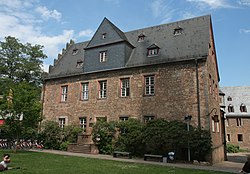German House (Marburg)
| German house | ||
|---|---|---|
 The German House seen from the Elisabeth Church |
||
| Data | ||
| place | Marburg , Hesse | |
| Construction year | 1243/35 to 1250 | |
| Coordinates | 50 ° 48 '54.9 " N , 8 ° 46' 13.7" E | |
|
|
||
The German House (also Deutschordenshaus or Deutschhaus ) was the original residence of the Teutonic Order in Marburg ( Hesse ). The oldest parts of it come from the time between 1234/35 and 1250 and therefore dates from the time when the Elisabeth Church was built in the immediate vicinity (foundation stone laid in 1235).
Building history
The oldest parts of the German House (cellar vaults of the east part of the central building and the south west wing) date from between 1234/35 and 1250. The Komturhaus (north part of the east wing) came around 1250/60, and in 1480 the so-called new building and the west wing was added. The German House only got its present form through a large number of additions and conversions.
The use of the individual building parts and floors changed several times during the monastery period (until around 1475) and during the residence period (until 1809). The complicated history of the building is still unclear in detail. In the middle building, the so-called manor house, there were originally various offices (= work and work rooms). Around 1480, Landkomtur Ludwig von Nordeck had the initially open arcade wall built in front of the courtyard; In the 1780s, the half-timbered upper floor and the mansard roof took the place of a pointed roof.
At the beginning of the 18th century, the Landkomtur Hugo Damian von Schönborn (1700–1743), whose coat of arms is above the main entrance and under which the Teutonic Order in Marburg once again experienced a brief boom, moved his residence to the central building. The baroque entrance portal was moved to its current location after the old commandery was demolished. Inside, the so-called men's kitchen (“ox roasting ”) in the basement and the mighty fireplace are particularly impressive. The west wing, the so-called Brothers House, served u. a. as a bedroom and dining room. The lower, courtyard-side (eastern) Renaissance porch with three coat of arms stones was built in 1572. In the northern, oldest part of the east wing was u. a. the commander's apartment. Ludwig von Nordeck began in 1484 and Dietrich von Cleen (coat of arms on the ornamental oriel of the southern stepped gable wall) completed the so-called new building as the southern part of the east wing in 1495 . In 1530/31 a choir bay was placed in front of the house chapel on its east wall. Of the old commandery, which adjoins the older part of the east wing and was demolished in 1893, only a columned gallery has been preserved.
The ensemble of the former commander of the Teutonic Order includes u. a. also the Kornhaus located directly to the east of the German House , which today houses the Mineralogical Museum of the Philipps University of Marburg .
Use by the university
The German House has been used by the university since the 1820s. The following departments and institutions used it:
- Physics (1823–1838),
- Maternity home (1823–1868),
- Zoology (1824-1903),
- Chemistry (1825–1881),
- Mineralogy and Geology (1881 and 1904 respectively until the mid-1970s).
Todays use
In the summer semester of 1977, the Geography Department of the Philipps University of Marburg moved into the building. Almost always the move in the above. Institutes anticipate structural changes, most recently from 1975 to 1977. Since then, the lecture halls, library, staff, collection and seminar rooms as well as various laboratories have been located there on over 2,000 m² of main usable area.
Trivia
The Deutsches Haus is the namesake of Deutschhausstrasse, which is an important inner-city street in Marburg and opens up the hospital district.
literature
- Ursula Braasch-Schwersmann : The Teutonic Order House in Marburg. Economy and administration of a late medieval rulership (= studies and materials on constitutional and regional history. Volume 11). Elwert, Marburg 1989, ISBN 3-7708-0907-6 (Zugl .: Marburg, Univ., Diss., 1988).
Web links
Individual evidence
- ^ A b Christoph Reudenbach: History of the German House. The Institute of Geography and the German House. (No longer available online.) In: uni-marburg.de. University of Marburg , June 25, 2013, archived from the original on April 12, 2018 ; accessed on March 26, 2019 .


